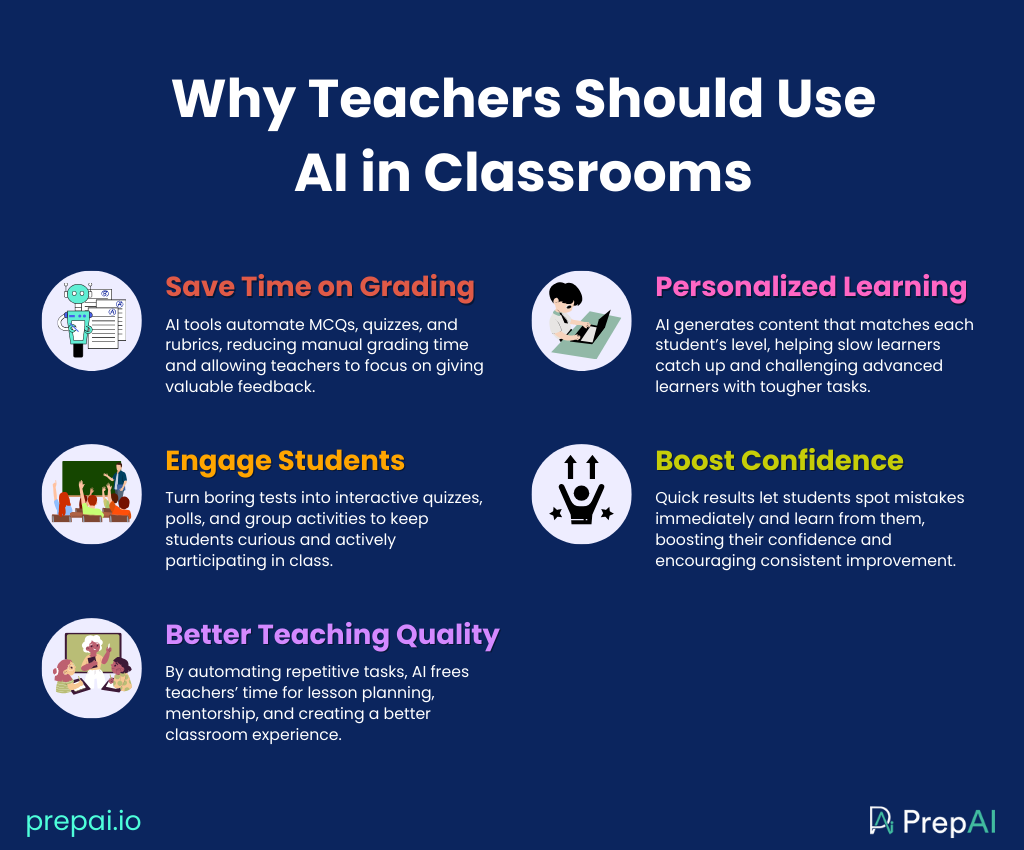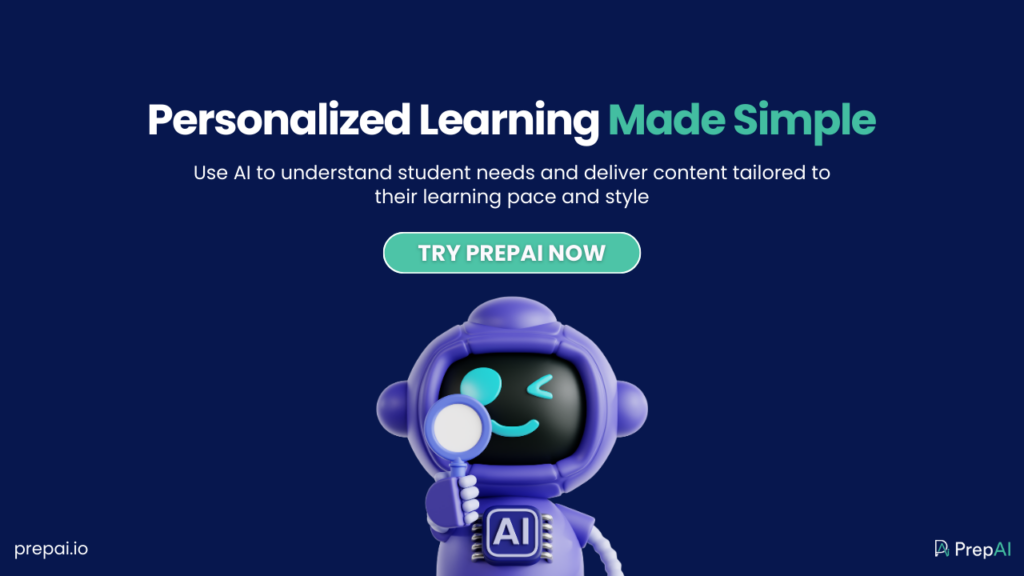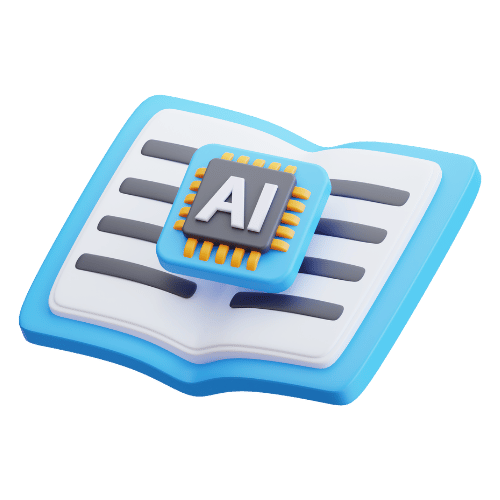AI tools are the software applications that are backed by artificial intelligence to perform tasks like decision-making and problem-solving. AI tools are being used in almost every industry, and education can be the most beneficial with them. Let’s understand more about how AI can ease the workload of the educators.
Grading assignments, organizing classes, monitoring student development, and running classrooms in a limited time is quite overwhelming. Particularly at educational institutions where resources are scarce and class sizes are high, the strain is only increasing. The educators have to face huge burnout, and being unable to offer personalized instruction that decreases student engagement. The whole purpose of AI tools for educators is to allow them to focus on teaching and helping students grow. Educational AI tools are helping teachers concentrate more on what really matters, which is teaching. AI automates tedious activities and provides insightful data about student performance.
Around 50% of the educators use AI for lesson planning, and 37% of the educators use tools like PrepAI for classroom or assessment generation. You can recover hours that you could spend interacting with students by implementing AI tactics and utilizing successful platforms for test making. With the correct resources, even minor changes can have a significant impact. Using the right approach, you can teach more and manage less, whether your goal is to increase engagement, reduce effort, or simply regain a few hours per week.
Classroom productivity tools provide improved support and efficiency to both students and teachers by automating repetitive chores, personalizing learning materials, and tracking student progress in real-time. In the African context, where recent aspirations towards universal education are limited by capacity, the use of AI in education can provide critical support and has potential mechanisms for reducing quality gaps in what is otherwise a constrained resource environment. Let’s get deep insight into how AI tools help educators to save their time and enhance productivity simultaneously.
Why Educators Must Integrate AI Tools While Teaching
With the goal of overcoming technological obstacles and optimizing its influence on student learning outcomes, Rising Network Academy in Africa is investigating a multidimensional strategy to integrate AI in its classrooms. Their strategy is based on the goal of using AI to assist teachers without replacing them, while also streamlining administrative duties and improving the teaching and learning process overall. By relying on educational AI tools, educators can:
Reduce Grading Time By Using Smart Assessment Tools
Grading takes time that educators don’t have. For example: High school math teachers spend many hours each week on problem sets and entering grades. Elementary school teachers spend endless hours reviewing stacks of worksheets and writing samples. If you consider your process for grading and formative assessment, you can realize the actual potential of smart assessment tools and the role of AI in dramatically reducing teachers’ marking burden. The best part? You’ll be able to save time spent on repetitive tasks. Thus, you can focus on providing meaningful feedback and personalized instruction to support student learning.
The leading AI educational platform, like PrepAI, helps educators create assessments across three primary value positions: aligning to standards and building very detailed rubrics, generating individualized feedback based on student responses, and maintaining a consistent evaluation process that helps you work more swiftly. These platforms can create assessments in different formats, like MCQs, fill-in-the-blanks, quizzes, true/false, and more, helping them target students’ weak subjects and offering apt support.

Develop Differentiated Content in Minutes, Not Hours
Every classroom is a diverse subset of student abilities. Generating materials to accommodate everyone is one of the greatest challenges of teaching. AI-enabled differentiation tools allow you to create many paths to the same learning objective. Platforms can adapt reading levels, easy to complex tasks, and challenge advanced learners, all with your input and alignment to standards. With AI tools for education, educators can help students learn better because teachers can quickly understand where each student is lacking and offer them personalized teaching to make them grasp things better and for longer periods.
Using question-answer generators like PrepAI gives students several methods to obtain content and modify explanations in response to their responses. This tool can create differentiated assessments on the basis of knowledge of the students. Teachers can generate mental ability tests, or functional assessments, using AI. AI will always create fresh content material according to the content provided. Thus, the content generated is unique, specific, and personalized.
Building Student Engagement
It is quite challenging for teachers to engage students in classes, especially in large or diverse classrooms. Educational AI tools make learning more interactive by transforming boring assessments into engaging experiences. The test makers for teachers encourage students to apply knowledge in real-world contexts. Tools like PrepAI can encourage learners and support diverse sparks of curiosity to keep students involved from start to finish.
Educators can use quiz prompts to build short assessments in different formats. These challenges make education fun for the students, and the focus of the lesson changes from passive listening to active engagement. This tool even allows students to come up with their own queries. When students challenge one another in group activities, teachers use peer-to-peer questioning features to foster collaboration and a sense of ownership over learning. Moreover, in Africa, Rising Academy ensures that their AI math tutor responds to students’ performance, specifically by creating generative chats that assist students in setting, monitoring, and reflecting on learning objectives. By adding text-to-speech functionality they are trying to make the content easier to understand for students whose first language is not English and those who are struggling readers.
Develop Confidence through Active AI Engagement
You do not need any formal training to use AI tools for lesson planning in your classroom. The best method to develop confidence is to choose one tool, such as an AI lesson planner or AI quiz generator, that helps educators make students learn instantly and without too much effort. When integrating regularly with AI, it can set up an active engagement that boosts the confidence of both teachers and students. Teachers can simplify complex topics by turning them into easy-to-understand quiz questions and turn errors into growth opportunities.
It allows students to get feedback in no time, which allows students to correct mistakes instantly. Teachers can create gamified quizzes, MCQs, fill-in-the-blanks, HOTS, and subjective questions with AI. Educators can even create these questions by uploading their own content (text, audio, video, links, and more), making assessments interactive and dynamic to build confidence in the students. It allows them to learn more topics or weak topics again and again by strengthening their learning.
Facilitate Quality Teaching
Recognizing the importance of well-prepared teachers is critical, and Rising Network in Africa is developing an initiative to use large language models to ultimately develop interactive prompts for teachers prior to lessons that facilitate teacher understanding of lesson content before delivery and practice opportunities. The prompts will reinforce the teacher’s access to knowledge about their lesson, remind them of key points, and practice action on them.
Quality teaching is more than just checking off boxes from a syllabus. It’s about developing great learning experiences that reach all students. With tools like PrepAI, teachers can design quizzes, tests, and assessments for teachers and grade those assessments, freeing educators from time-consuming tasks. Teachers can now have instant access to differentiated assessments so they add more energy into lesson planning, collaborative discussions, and providing tailored resources. Thus, it allows educators to spend more time teaching, mentoring, and inspiring, all of which align with quality teaching.

Conclusion
AI will never replace teachers but instead will assist teachers to be smarter and more effective. AI will bring teaching into the 21st century and help teachers use intelligent teaching tools like PrepAI that will help them save time and develop a more efficient learning, planning, and assessment process for students. With the opportunities for personalized feedback, prediction, and even engaging experiences, AI could make the teaching process easier and more productive.



